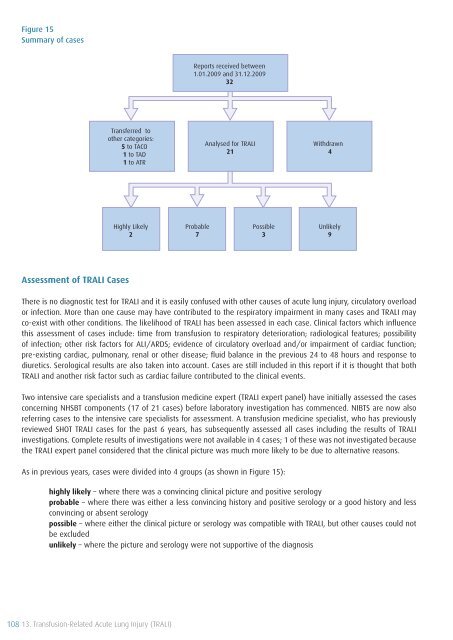SHOT Annual Report 2009 - Serious Hazards of Transfusion
SHOT Annual Report 2009 - Serious Hazards of Transfusion
SHOT Annual Report 2009 - Serious Hazards of Transfusion
Create successful ePaper yourself
Turn your PDF publications into a flip-book with our unique Google optimized e-Paper software.
Figure 15<br />
Summary <strong>of</strong> cases<br />
<br />
<br />
<br />
<br />
<br />
<br />
<br />
<br />
<br />
<br />
<br />
<br />
<br />
<br />
<br />
<br />
<br />
<br />
<br />
<br />
Assessment <strong>of</strong> TRALI Cases<br />
There is no diagnostic test for TRALI and it is easily confused with other causes <strong>of</strong> acute lung injury, circulatory overload<br />
or infection. More than one cause may have contributed to the respiratory impairment in many cases and TRALI may<br />
co-exist with other conditions. The likelihood <strong>of</strong> TRALI has been assessed in each case. Clinical factors which influence<br />
this assessment <strong>of</strong> cases include: time from transfusion to respiratory deterioration; radiological features; possibility<br />
<strong>of</strong> infection; other risk factors for ALI/ARDS; evidence <strong>of</strong> circulatory overload and/or impairment <strong>of</strong> cardiac function;<br />
pre-existing cardiac, pulmonary, renal or other disease; fluid balance in the previous 24 to 48 hours and response to<br />
diuretics. Serological results are also taken into account. Cases are still included in this report if it is thought that both<br />
TRALI and another risk factor such as cardiac failure contributed to the clinical events.<br />
Two intensive care specialists and a transfusion medicine expert (TRALI expert panel) have initially assessed the cases<br />
concerning NHSBT components (17 <strong>of</strong> 21 cases) before laboratory investigation has commenced. NIBTS are now also<br />
referring cases to the intensive care specialists for assessment. A transfusion medicine specialist, who has previously<br />
reviewed <strong>SHOT</strong> TRALI cases for the past 6 years, has subsequently assessed all cases including the results <strong>of</strong> TRALI<br />
investigations. Complete results <strong>of</strong> investigations were not available in 4 cases; 1 <strong>of</strong> these was not investigated because<br />
the TRALI expert panel considered that the clinical picture was much more likely to be due to alternative reasons.<br />
As in previous years, cases were divided into 4 groups (as shown in Figure 15):<br />
highly likely – where there was a convincing clinical picture and positive serology<br />
probable – where there was either a less convincing history and positive serology or a good history and less<br />
convincing or absent serology<br />
possible – where either the clinical picture or serology was compatible with TRALI, but other causes could not<br />
be excluded<br />
unlikely – where the picture and serology were not supportive <strong>of</strong> the diagnosis<br />
108 13. <strong>Transfusion</strong>-Related Acute Lung Injury (TRALI)












